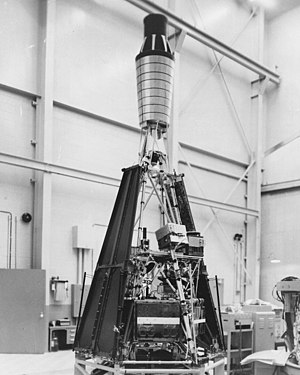Ranger 2
| Ranger 2 | |||||||
|---|---|---|---|---|---|---|---|
 Ranger 2 |
|||||||
| NSSDC ID | 1961-032A | ||||||
| Mission goal | Photographing the moon | ||||||
| Client |
|
||||||
| Launcher | Atlas - Agena-B | ||||||
| construction | |||||||
| Takeoff mass | 304 kg | ||||||
| Course of the mission | |||||||
| Start date | November 18, 1961 | ||||||
| launch pad | CCAFC LC-12 | ||||||
| End date | November 20, 1961 | ||||||
|
|||||||
Like its predecessor, Ranger 1, Ranger 2 was a NASA space probe for testing scientific equipment. The launch took place on November 18, 1961 aboard an Atlas - Agena-B missile from the launch pad LC-12 at Cape Canaveral Air Force Station .
On board, the probe had, among other things, experiments to observe cosmic rays and the earth's magnetic field . She had a weight of 304 kilograms. The structure was almost identical to Ranger 1. Both were built in the so-called Block I design .
After the successful start and reaching the park orbit in a 130 to 150 km high earth orbit , a new ignition should bring the probe onto a strongly elliptical orbit. Due to a malfunction, the re-ignition of the high school failed. As a result, Ranger 2 could not reach the desired height and burned up in the earth's atmosphere on November 20, 1961. Despite the failed ignition, NASA rated the mission as a partial success, as it had been proven that it is technically possible to start experiments or measurements from Earth and obtain results.
source
- Werner Büdeler: Moons by human hands . Pp. 196 to 198.
Web links
- Bernd Leitenberger: The Ranger lunar probes
- Nasa website about Ranger 2 (English).